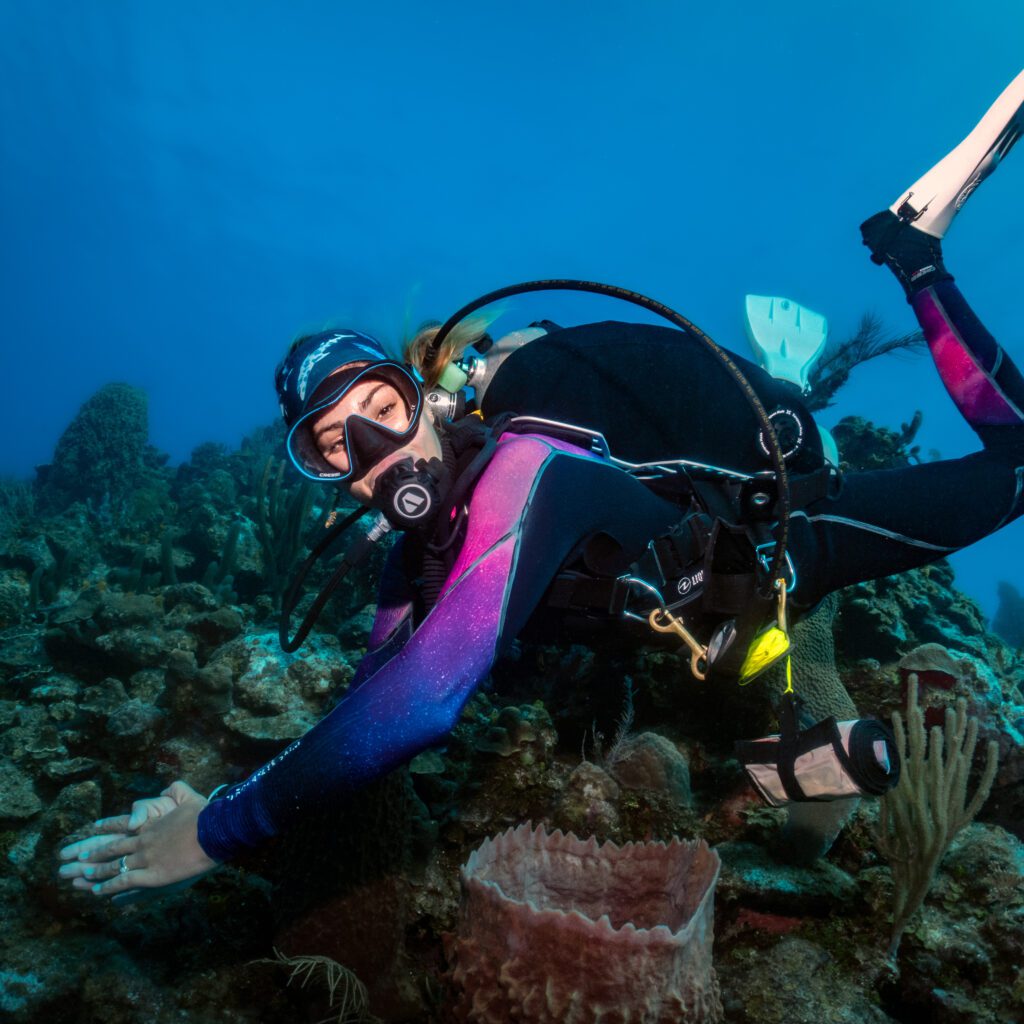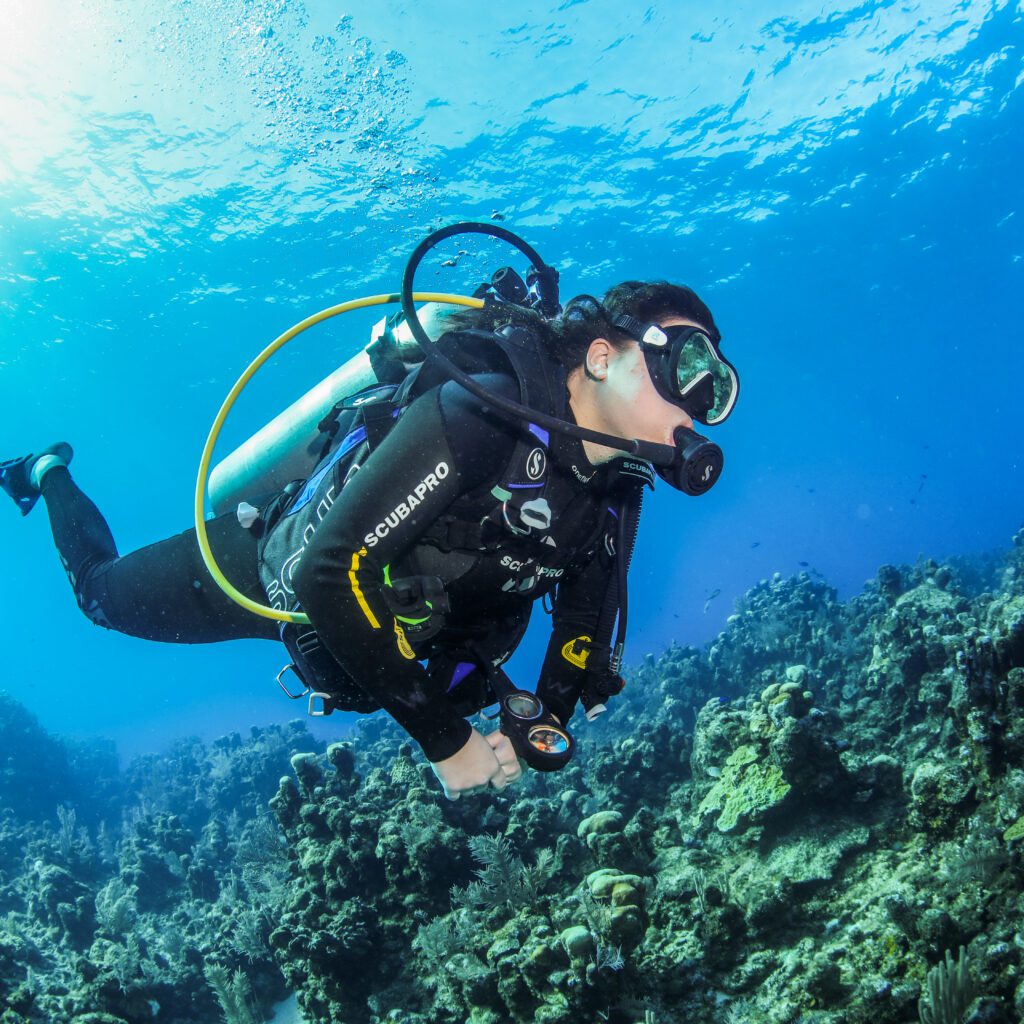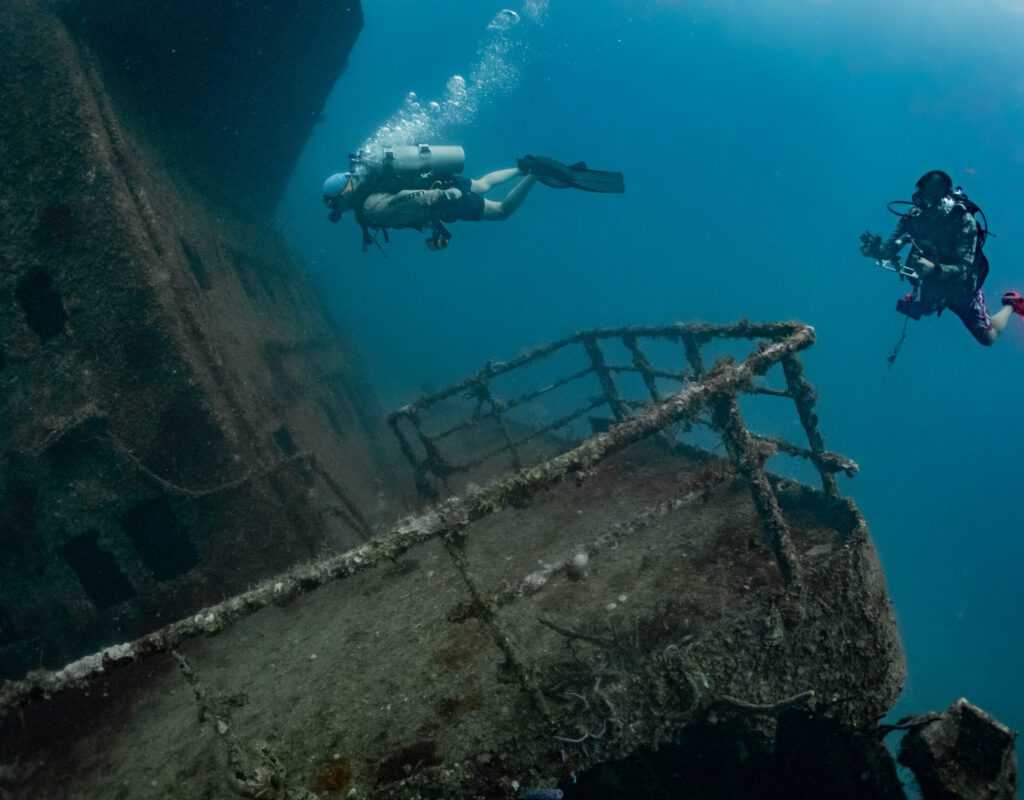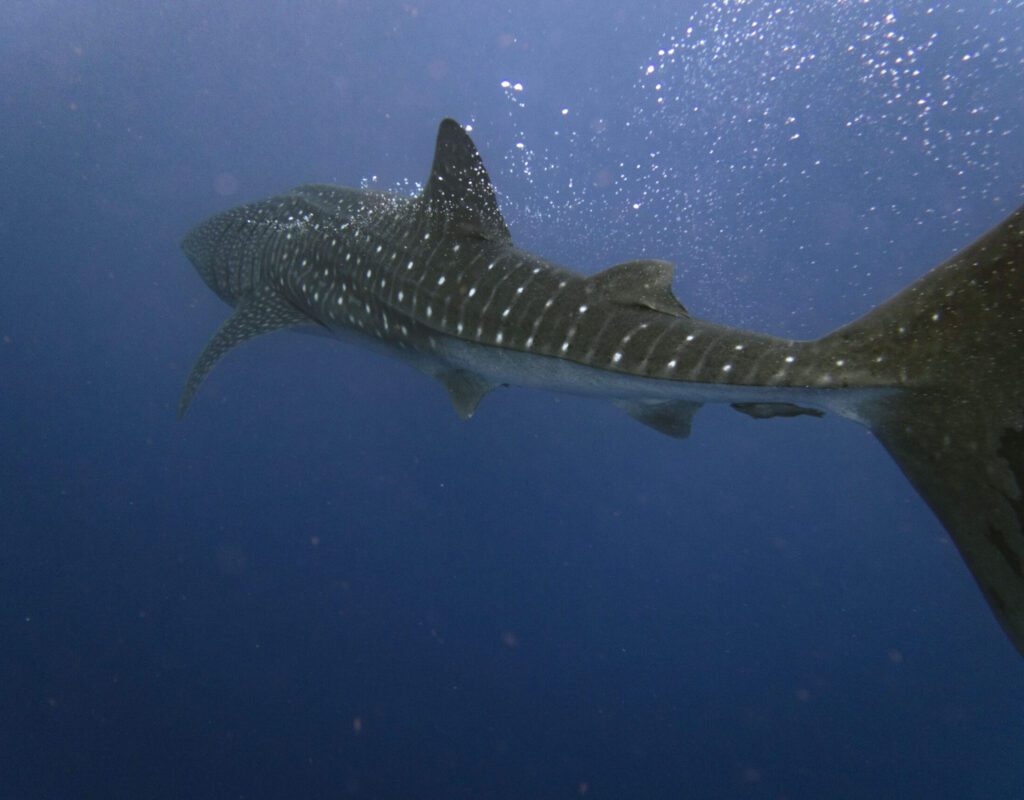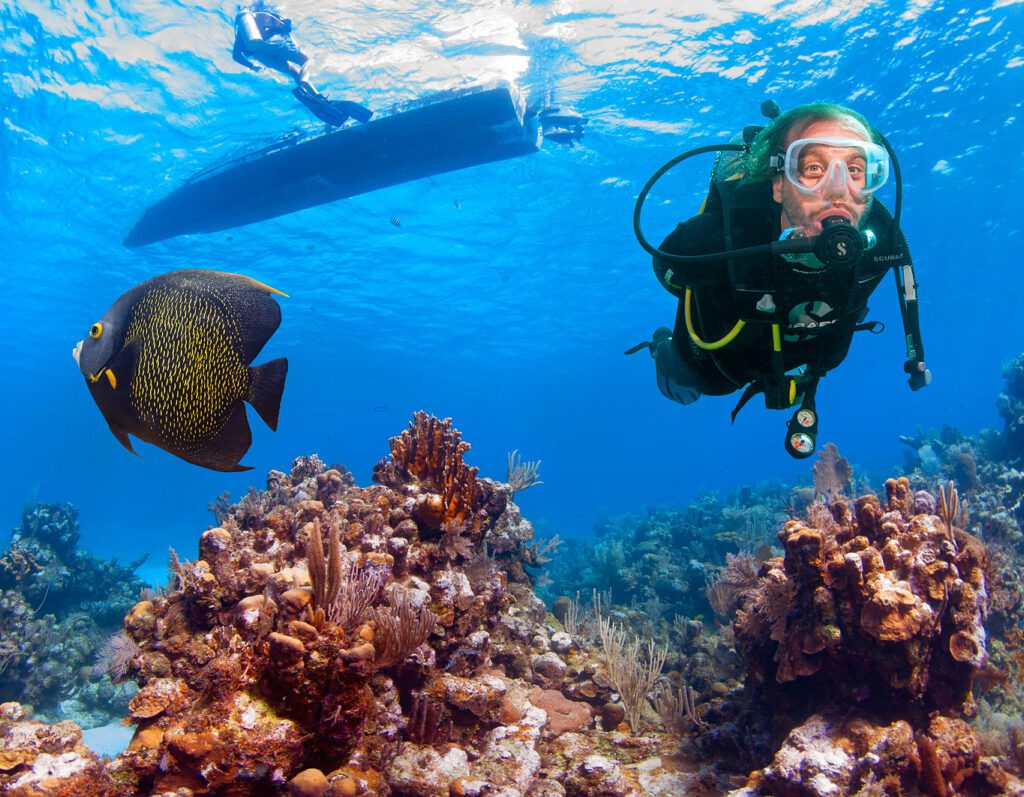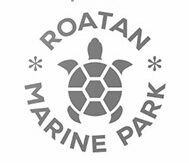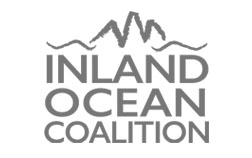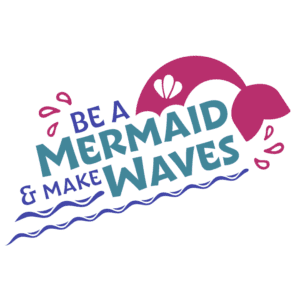By Author
7 Reasons Why Roatan is Great for Diving
If you’re searching for an unforgettable diving experience, look no further than Roatán. This tropical island offers many reasons for why it’s the perfect destination for divers seeking adventure, natural beauty, and marine biodiversity. Let’s explore the enchanting wonders that make Roatan great for diving.
1. World-Class Dive Sites in Roatan:
Roatan is a diver’s playground. As part of the Mesoamerican Barrier Reef, it has an abundance of dive sites to suit every preference and skil level. This makes Roatan great for diving! Whether you’re a new or an experienced diver, there’s a dive site that will leave you stunned. From vibrant coral reefs teeming with marine life, to jaw-dropping wall dives and intriguing shipwrecks. Each dive in Roatan promises a new and exciting underwater adventure.
Want to know which dive sites are our favorite? Check out our Top 10 Roatan Dive Sites list.
2. Endless diving opportunities year-round:
One of the remarkable features of Roatan is its year-round diving opportunities. Thanks to its great location the climate is very steady throughout the year. Roatán is great for diving at any time of the year. With warm temperatures and minimal rainfall through most of the year, you’ll experience excellent visibility and calm waters. This ensures an unforgettable diving experience whenever you choose to visit. If you’re interested in when the best time to come visit Roatan is, check out our blog post.
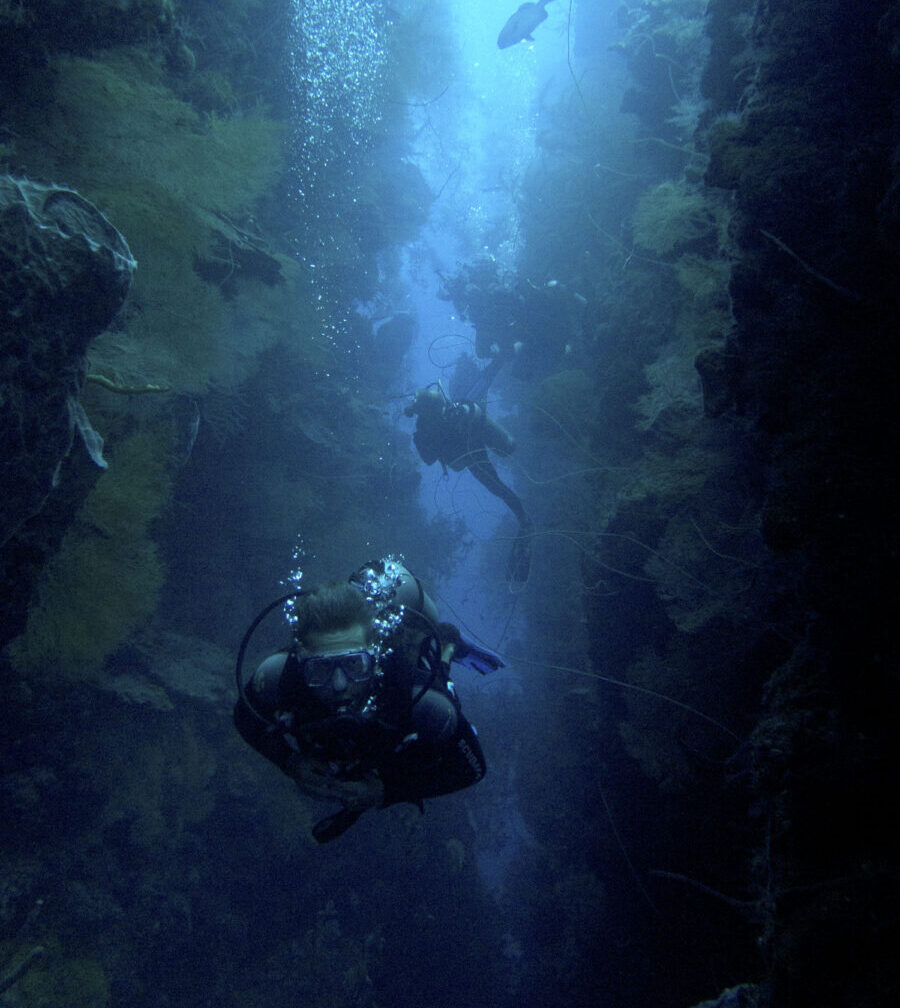
3. Easy access and short travel:
Getting to dive sites in Roatan is a breeze. Sun Divers is located right at the doorstep of many of our favorite dive sites. So, it’s often just a few minutes by boat. Short boat rides mean less time commuting and more time exploring the captivating underwater world. We offer two tank morning dives and afternoon explorations. If you’re up for an adventure we can also full-heartedly recommend our night dives. Thanks to the short commute you’ll still make it back on time for a nice dinner afterwards. See our favorite places to eat!
4. Ideal for learning:
Roatan is the best place to get scuba certified. The year-round calm and clear waters of Roatan create a comfortable and welcoming environment. This means you focus on learning to scuba dive or advancing your skills without also trying to navigate tricky dive conditions. Roatan is an ideal destination for beginners and those looking to expand their diving proficiency. You can sign up for any of our courses any time of the year. Check out the courses available at Sun Divers and get your PADI in Roatan! At Sun Divers, you’ll find a team of experienced staff and instructors from diverse backgrounds. We are ready to guide and support you on your diving journey
5. An abundance of marine biodiversity:
Roatan is a haven for marine life enthusiasts. As soon as you’re beneath the surface, you’ll be greeted by an awe-inspiring world of biodiversity. Encounter majestic eagle rays gracefully soaring through the water. Catch a glimpse of sea turtles gracefully gliding by. And witness a great variety of colorful tropical fish species in their natural habitat. Into the smaller stuff? You can also find an array of macro life from millimeter size nudibranchs to interesting small shrimp and crab species. Roatan’s rich ecosystem is truly a treasure of marine wonders waiting to be explored.
6. A protected marine park:
One of the reasons why Roatan is great for diving and has such breathtaking marine biodiversity is its conservation efforts. The island is surrounded by a protected marine park. At Sun Divers, being ‘always eco-active’ is a core value and we’re proud to sponsor the Roatan Marine Park, as well as donate the use of our boats and employee volunteer time for coral restoration activities. We actively promote and practice sustainable diving. Emphasizing respect for marine life and habitats is imperative to us and we require all of our divers to support the annual Roatan Marine Park access fee ($10) which goes toward the protection of the park. By choosing to dive with Sun Divers, you contribute to the preservation and protection of Roatan’s fragile marine ecosystem, ensuring its beauty can be enjoyed for generations to come. We share this passion and dedication with our dive community and offer a Coral Ambassador course in which you can learn to help with coral restoration.
7. More than just diving!
Roatan isn’t just a diver’s paradise. It also offers a great hotel and restaurant scene that adds to the island’s appeal. After a day of diving and exploring the underwater wonders you can treat yourself to a culinary adventure on land. Roatan boasts a range of dining options that cater to various tastes and preferences. Charming seaside seafood shacks are serving up the freshest catch of the day. And upscale restaurants offer international cuisine. There’s something to satisfy every taste.
Discover our 10 Top Restaurant Recommendations While in Roatan!
What are you waiting for?
Roatan is great for diving – That is undeniable! This island embodies everything and more that you wish for when diving. Embark on an unforgettable journey with Sun Divers and immerse yourself in the magic of Roatan’s underwater realm. Let the island’s natural beauty and captivating marine encounters leave its mark on you. Roatan is great for diving. Come discover its hidden treasures with us. Contact us so that we can put together en epic dive trip itinerary for you!
Do You Need a Wetsuit to Dive in Roatan?
Roatan is a Caribbean paradise known for its scenic and beautiful reefs. Its warm tropical waters attract a diversity of marine life and many divers each year. But are Roatan’s waters so warm that you don’t need a wetsuit to dive in Roatan?
Generally, yes, most people need a wetsuit to dive in Roatan. But depending upon the year and personal preference, the type of exposure suit you need can vary from full 3mm to even just a rashguard.
Let’s explore the 5 factors that can help you decide if you need a wetsuit to dive in Roatan and what type of wetsuit is best for you:
1. Water temperature
While Roatan enjoys cozy tropical waters throughout the year, the temperature can vary slightly depending on the season. The average water temperature ranges from 80°F (25°C) to 84°F (29°C). The water tends to be warmer during the summer months from May to September. The temperature slightly drops during the winter months from October to April. If you’re on the “get-cold easy” side or plan to do multiple dives a day, a wetsuit can provide added comfort and insulation.
Most divers choose to wear a 2.5mm shorty or even just a rash guard and leggings during the summer months. And then a full 3mm wetsuit during the winter months. People who get colder might also opt to add an extra layer of protection with a hooded vest under their wetsuit to dive in Roatan. Then there are those who seem to run hot year-round and opt for just a shorty or rash guard any time of year. This gives them ultimate freedom and mobility – but isn’t for the faint of heart!
If you want to find out more about the weather in Roatan throughout the year, read our post on: When is the best time to dive in Roatan?
2. Dive duration
The longer you’re in the water, the colder you might get. For short dives in shallow water, you’ll maybe be comfortable enough without a wetsuit. But for longer dives a wetsuit can help regulate your body temperature and protect you from potential heat loss. It’s really annoying to not enjoy your dive because you’re too cold. You might also get cold, when you’re doing multiple dives a day. At Sun Divers, all fun dives are at least 60 minutes. Consider how long your dives and surface intervals will be for your decision on if you need a wetsuit to dive in Roatan or not.
3. Dive depth
Another factor to consider when deciding whether you want to wear a wetsuit to dive in Roatan is your dive depth. As you descend into deeper waters, the temperature drops. In Roatan, the water temperature starts to cool when you descend beyond approximately 30 to 40 ft (9 to 12 m). You might feel the temperature drop a bit, especially if you spend an extended amount of time down there. If you’re into deep dives, Roatan has a few interesting dives that you might want to check out such as Hole in the Wall and our wrecks, The Aguila and Odyssey. It is important to note that the exact temperature variation can vary depending on factors such as the season and current as well.
In order to dive below 60 ft (18m) you need to be Advanced Open Water certified or do it as an Adventure Dive. You can find out about the benefits to get Advanced Open Water certified in our blog post.
4. Personal comfort
Every diver has their own preferences and comfort levels when it comes to ideal water temperatures. Some divers may feel comfortable diving without a wetsuit in Roatan’s warm waters. Others may prefer the added comfort, protection and warmth that a wetsuit provides. Ultimately, it is a personal choice based on your individual comfort and needs. Regardless of your decision, we always recommend wearing a rash guard or mineral-based sunscreen to protect your skin from the sun’s rays. If you do wear sunscreen please avoid petro-chemical sunscreens.
You can find out more about reef safe sunscreen.
5. Protection
Besides temperature regulation, wetsuits also offer additional benefits such as protection against the sun’s harmful rays or jellyfish stings. Diving in tropical environments closer to the equator means being exposed to intense sunlight, and wearing a wetsuit can provide a layer of UV protection for your skin. Luckily, we don’t see many jellyfish in Roatán. But occasionally, they hang out at the surface during night dives. If there is any, a wetsuit will protect you from being stung.
Gloves are not allowed
Did you know that in the Roatan Marine Park, the use of gloves during diving is not permitted? There are good reasons for this regulation. The main purpose of the Roatan Marine Park is to protect and preserve the delicate marine ecosystem of this incredible reef. This includes the corals and other marine life. Gloves can unintentionally cause damage. The texture of gloves can damage corals and other fragile organisms when touched. Gloves may also give divers a false sense of security. This can lead to careless contact with delicate structures. Eco friendly and sustainable diving practices are a top priority at Sun Divers. By respecting the “no gloves” policy, we can contribute to the conservation efforts of the marine park and ensure that no one is “touching, taking or teasing” the wildlife.
We’ll help you choose
At Sun Divers, we understand that divers have different preferences when it comes to thermal protection and sun exposure. Our experienced staff will guide you and give you recommendations based on current water conditions, your individual preferences, and the dive site characteristics. We offer a variety of different style and thickness wetsuits to rent from including 3mm full wetsuits, shorties and a variety of rash guards.
If you prefer to purchase your own wetsuit we are a certified Scubapro dealer and we offer deals, as well as direct shipping to Sun Divers customers.
Whether you choose to dive with a wetsuit, a rash guard, or without any additional protection at all, discover the beauty of our underwater world and embark on unforgettable diving adventures in Roatán with Sun Divers. We prioritize safety, small group diving and epic adventures.
So, do you need a wetsuit to dive in Roatán? The choice is yours, and we’re here to support you every step of the way as you explore the wonders beneath the surface of the Caribbean Sea. Contact us for more information.
5 Reasons to Get PADI Advanced Open Water Certified
Are you weighing the cost vs. benefit of getting your PADI Advanced Open Water certification? If so, you’re not alone. When you become open water certified, you’re technically able to do any recreational dive. So you might be thinking ‘why get my advanced?’
But we promise, you learn and experience something new with the PADI Advanced Open Water certification – whether you’re a new open water diver or have been exploring depths for decades. And the more training you have, the safer a diver you’ll be, which is never a bad thing. Plus, the course is only two days, requires minimal self study time and is just plain fun to do.
Not convinced yet? Here’s a few good reasons that we think will convince you to get your PADI Advanced Open Water. And hopefully you’ll do it in Roatan!
1. Elevate your expertise
Whether you’re still new to diving or already have hundreds of dives logged, the PADI Advanced Open Water course presents the perfect opportunity to build upon the fundamental skills you have acquired. It enables you to expand your knowledge of dive theory and skills proficiency, so that you’re well-equipped for the challenges and wonders that lie beneath the surface.
The PADI Advanced Open Water certification is fun and flexible, and it takes a more hands-on approach to learning. You learn by diving: No written exams required! Instead, you have informative briefings before and after each dive, and you practice achieving dive objectives and safety protocols.
You can gain a deeper understanding of how to control your buoyancy with your breath in the Peak Performance Buoyancy adventure dive. Or you can learn the proper way to signal and communicate with your dive buddy during night dives. When you immerse yourself in these real diving scenarios, you gain hands-on experience and practical knowledge that deepens your expertise.
2. Gain access to advanced dive sites
If you dive with a reputable dive shop, they will only take you to your training limits. This is especially true when it comes to advanced deep dives, night dives or wreck penetration. Without your advanced certification, reputable dive shops in Roatán won’t take you to see our majestic wrecks at 100 feet or on a night dive to see the String of Pearls.
As an open water diver, you can dive to 60ft/18. When you get PADI Advanced Open Water certified, you are trained to dive to 100ft/30m. Roatán deep dives include wrecks such as El Aguila and the Odyssey shipwreck, as well as an amazing swimthrough experience at Hole in the Wall. These dives are also a great opportunity to develop your deep diving skills. And the Deep Adventure dive in the PADI advanced open water course counts toward the PADI Deep Diver Specialty.
There are also a few dive sites in Roatan that are worth diving on Nitrox. The Enriched Air specialty certification is offered at a discount when bundle it with the PADI Advanced Open Water course at Sun Divers. Check out the benefits of diving Nitrox.
The Open Water course teaches the fundamental skills and safety procedures of diving, but the PADI Advanced Open Water course focuses on expanding those skills and introduces divers to new dive environments and scenarios. Divers complete 5 adventure dives. Each dive focuses on a specific type of diving or skill. The best part: You can get Advanced Open Water certified in Roatán in only 2 days. While navigation and deep diving are mandatory adventure dives, you have the flexibility to explore 3 additional specialties such as:
- Night Diver
- Fish Identification
- Drift Diving
- Peak Performance Buoyancy
- Wreck Diving
- Underwater Naturalist
- Digital Underwater Photography
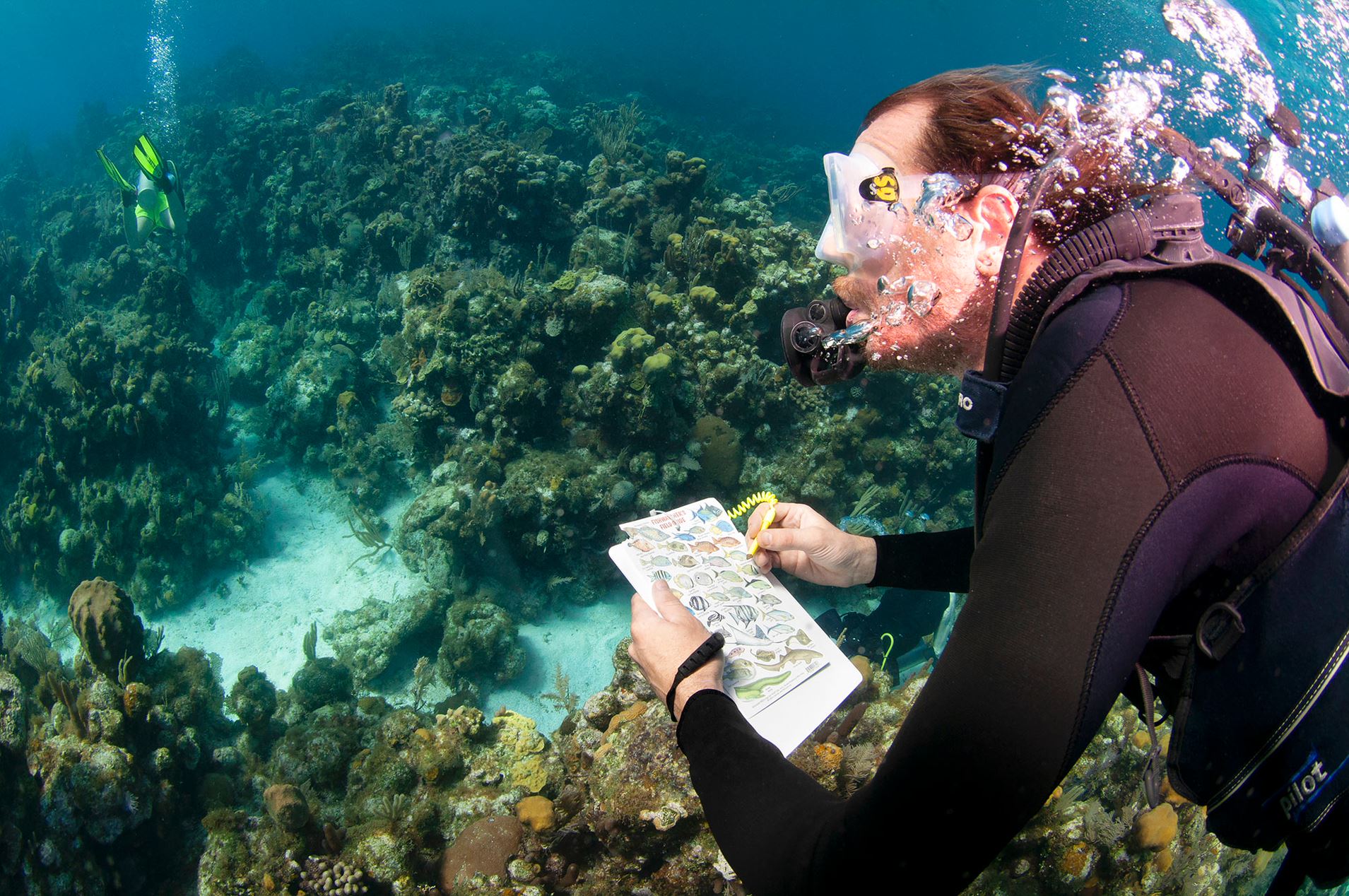
During the Fish Identification Adventure Dive you can learn how to properly identify various groups of fish in Caribbean waters and around the world.
3. Dive with more confidence
With each adventure dive, you gain remarkable growth in your confidence as a diver. By applying your skills in different dive scenarios, you develop the ability to adapt to a variety of conditions and environments. This newfound confidence will enable you to explore with a sense of ease and safety. You’ll know that you have the knowledge and training to handle different situations.
4. Make your dives more interesting
The skills you perform during the PADI Advanced Open Water course add an interesting new twist to diving. This makes it an entertaining course to take, especially if you feel like you’ve seen and done it all in diving or love a good mental challenge. You will try your hand at number games and math at depths to safely learn how nitrogen narcosis can affect decision making and motor skills. You’ll learn how to easily use a compass under water – and on land for that matter! And you can go through an underwater obstacle course to practice staying neutrally buoyant or learn underwater photography basics.
5. It’s required for other courses
The PADI Advanced Open Water is the first continuing education course you need this certification if you have any interest in other PADI courses. It’s a requisite for Rescue Diver and Divemaster. And you must be advanced certified or at least have your PADI Adventure cert in order to achieve most of the PADI specialty certifications. Luckily, the adventure dives also count toward one of the open water dive requirements for all the specialties – so you get some bang for your buck there!
Why Get Your PADI Advanced Open Water in Roatan?
With Roatán’s year-round diving opportunities, you can get certified at any time of the year. Immerse yourself in a wide variety of exhilarating dives, from deep sea swim throughs to intriguing shipwrecks. When you embark on your PADI Advanced Open Water certification journey with Sun Divers you’ll get to learn with a experienced and knowledgeable instructors from diverse backgrounds. You’oll enjoy the advantage of small course groups, ensuring personalized attention and a safe learning environment.
So, is it worth it to get your Advanced Open Water certification?
Whether you’re a recent Open Water certification holder or an experienced diver, the transition to become a PADI Advanced Open Water Diver offers an exciting opportunity to expand your expertise. It’s also a chance to connect more with the worldwide diving community. When you get PADI Advanced Open Water certified, you learn by diving. You will dive more confidently and be able to dive as deep as 100ft (30m). Embrace the thrill of real-world dive experiences, deepen your skills, and unlock your full dive potential.
Are you ready to embark on this extraordinary journey? Contact us to schedule your Advanced Open Water course in Roatan.
Can You Dive With Whale Sharks in Roatán?
Roatán is definitely a hidden gem of the Western Caribbean. And a true divers paradise. With its vibrant coral reefs, diverse marine life, and captivating underwater landscapes, it’s no wonder that divers love visiting this tropical island time after time. Whale sharks can be found on the bucket list of many divers. So you’re probably wondering: can you dive with whale sharks in Roatán? Many articles on the internet will tell you, yes. But in our experience, the answer isn’t quite so simple. So we are on the quest to uncover the truth about if you can dive with whale sharks in Roatán with the help of Gabriela Ochoa. She is a local marine biologist, who has recently founded the marine conservation nonprofit Ilili.
Does Roatán have whale sharks?
A frequently asked question by diving enthusiasts is, “Can I dive with whale sharks in Roatán?” While there have been rare sightings of these magnificent creatures near the island, encounters with whale sharks are exceptionally rare. Gabriela explains the chances of spotting a whale shark in Roatán are “once in a blue moon.” The Sea Lucas project, which has developed an interactive map for shark sighting in Roatán and the Bay Islands, reports only 2 reported whale shark sightings in Roatán since 2009. While numbers might be slightly higher due to lack of reporting, this is the most accurate source of data on Whale Sharks in Roatán. Utila, Roatán’s sister island, is considered a better spot for whale shark encounters – but even they have only had 7 reported sightings since 2009. The most common way for us to spot a whale shark is usually from the boat offshore. This means that encounters are very unpredictable and far out in the ocean. For this reason, most encounters end up being snorkel ones.
What is the best time of the year to see whale sharks?
Whale sharks are migratory creatures, traveling vast distances in the search of food and suitable breeding grounds. The presence in any given area is directly influenced by factors such as ocean currents, food availability and migration routes. Contrary to common belief, whale sharks are not vegetarian and feed on zooplankton as well. They have been observed to follow spawning aggregations of fish. Some bigger fish populations such as snappers are usually spawning during a certain season. Because of this, whale sharks are more frequently sighted between December to March around Roatán. Unfortunately, the depletion of fish populations in recent years has resulted in less frequent whale shark encounters in many places – including Roatán.
Diving responsibly with whale sharks in Roatán
While the desire to dive with whale sharks is understandable, it is vital to prioritize their natural patterns and habitats. As migratory species, these magnificent creatures require protection and conservation efforts to ensure their survival and to avoid any disturbance that may disrupt their delicate ecosystem. Unfortunately, many sites around the world that specifically promote whale shark diving might end up overwhelming and leaving these shy giants feeling stressed. At Sun Divers, we believe in practicing responsible and sustainable diving. If there ever is a whale shark sighting in Roatán, you can be sure we will approach it with utmost care and respect.
Unveiling Roatán’s marine treasures
It is not commmon to see whale sharks while diving in Roatán, but the island still offers an array of other captivating marine life encounters. As you explore Roatán reef sites, be prepared to experience a breathtaking variety of wildlife. In Roatán, divers are lucky to frequently encounter turtles, rays, and even some large marine mammals such as dolphins and pilot whales. There is rarely a ‘Turtle Tuesday’ in Roatán where a turtle isn’t showing its face. Of course, there is always an element of surprise and we can never guarantee the sight of specific wildlife while diving.
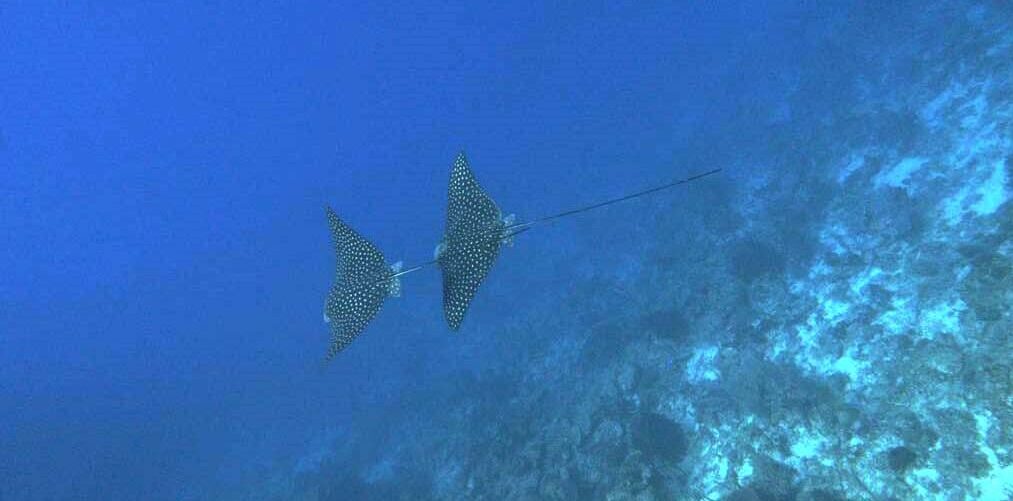
Two eagle rays are soaring through the waters in Roatán, Honduras.
Contribute to marine conservation while diving in Roatán
Eagle rays are among the stars of Roatán’s underwater world. These magnificent creatures, with their expansive wings and mesmerizing patterns, leave divers spellbound. Spotting an eagle ray gracefully gliding through crystal-clear waters is an experience that will be engrained in your memory forever. Monitoring and mapping of marine animals such as eagle rays and sharks is an important aspect of conservation. For this reason, it is helpful if you take pictures and report your sightings. “There is a lot of power in citizen science. Just contributing a picture can go a long way and has a great positive impact,” Gabriela said. Check out our guide on how to help with conservation.
Looking for a cool way to contribute to conservation while diving? Consider our RMP Coral Ambassador program!
In short – Are there whale sharks in Roatán?
While the chances of diving with whale sharks in Roatán may be rare, this marine paradise offers an abundance of incredible wildlife experiences. Keep an open mind and embrace the underwater wonders that await you. From elegant eagle rays to the vivid diversity of coral reefs, every dive is an opportunity to connect with the ocean’s beauty and contribute to its conservation. By practicing responsible diving, supporting local conservation programs, and spreading awareness about the fragility of marine ecosystems, we can together help protect Roatán’s natural heritage for years to come.
When is the Best Time to Dive in Roatán?
You probably think of Roatán as a great destination to escape the cold during snowy winters. And it is indeed a great place to enjoy the tropical weather of the Caribbean in the dead of winter. But, if you’re coming here for the best diving experience possible, we’ll let you in on a little secret: The summer is the best time to dive in Roatán. Our resident weather expert, Mike Andrews, has been updating weather reports on a daily basis for islanders and tourists alike through his Roatán Weather Facebook page and website. In this post, we’ll share what diving is like year-round on our island. But we’ll also give insights from Mike for those wishing to experience the most perfect conditions. Let’s dive deeper into why summer is the best time to dive in Roatán.
Dive in calm summer waters and explore the best sites
Many great dive sites, including most of our favorite spots, are on the west end of Roatán along the northern shore. And just minutes away from our dive shop by boat. The key to good diving conditions in Roatán is calm and clear waters. On the Northside, conditions can remain calm even when the predominant eastern winds blow. This allows for great visibility and easy navigation. We all love it when we don’t have to fight choppy surface waters and can spot that Eagle Ray from 100 feet away.
Weather expert Mike is a dive enthusiast himself and says, “The greatest conditions for diving are during the summer when the island is mostly free from cold fronts and from wind patterns that can disrupt the waters.” Low winds and calm seas during the summer also give us more opportunities to explore remote dive sites on Roatán’s east end. And also make day trips to the outer islands like Cayos Cochinos possible. While these special day trips can occur year-round, the probability of them happening are higher in the summertime. An extra bonus is that this amazing time of year is considered “low season” on the island. Meaning fewer people and usually lower rates on accommodations and flights. That’s just a few reasons why summer is the best time to dive in Roatán.
Year-round diving in Roatán
The winter months from December to February are the busiest time on the island. During the winter, Roatán can experience periods of strong northern winds up to 35mph/56kmh that push against the Northside of the island. This can potentially lead to murkier and choppier waters on the Northside of the island where we typically dive. We’re not ones to miss an opportunity to dive, so when weather affects conditions on the Northside, we opt to dive on the Southside. See how ‘Southside Days’ allow us to dive all year in Roatán.
The bottom line is that even if summer is the best time to dive in Roatán, you can find great diving year-round in Roatán. Conditions and weather will be more variable during the winter months, but that doesn’t mean that the diving isn’t spectacular. Here are more details on what Roatán weather and diving look like throughout the year.
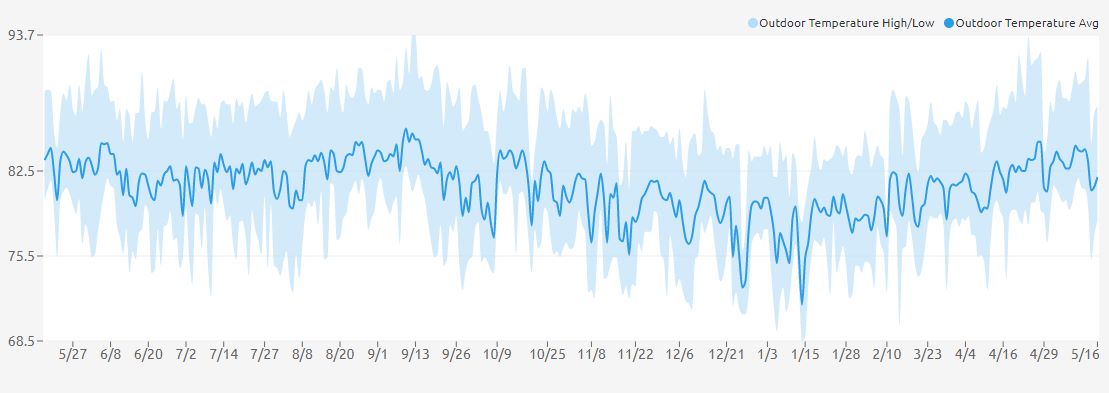
Temperature graph of the average temperature (°F) from May to May in Roatán, Honduras. Daily updates on Roatán weather can be found on Roatanweather.org.
Seasonal Guide to Roatán Weather & Diving Conditions
The summer months offer the best diving conditions in Roatán. But each season has its own unique features that divers might enjoy. Here are some highlights:
A little winter breeze | Roatán diving October – February
The temperature in Roatán averages 86°F/29°C year round. Winter averages are lower at 78°F/26°C with the lowest recorded temps at 66°F/ 19°C. During the winter months of October through February, the island can also feel cooler due to breezier weather.
This by no means requires you to bring your scarf or skiing socks. Days are balmy and skies are usually blue. But, you might not warm up as quickly in between dives. And the waters are slightly cooler at an average of 80°F/ 26°C. So we recommend that you add some additional exposure protection. If you’re one to get cold easily, be sure to wear a full 3mm suit and possibly add a hooded vest. If you usually dive as au naturel as possible – consider just a vest, long sleeve shark skin, or 3mm shorty.
During the winter, the winds can also bring rain fronts. When this happens, we choose dive sites that allow us to avoid areas where there might be runoff. But don’t let the misnomer “rainy season” deter you. We’re on a tropical island so rain is inevitable, but it usually comes and goes quickly and it’s very rare that we can’t find a good spot to dive, rain or shine.

Wind graph shows the average wind speed (mph) from May to May in Roatán, Honduras with cold fronts during the winter highlighted. Daily updates on Roatán weather can be found on Roatanweather.org.
The cool & calm spring | Roatán diving March – June
Weather in Roatán continues to be variable in the spring which is the driest season of the year. But generally winds, albeit high, stick to their predominant easterly direction. This keeps dive conditions calm and above-water temperatures comfortable. Waters start to warm up a couple of degrees and most people start to shed their full wetsuits opting for shorties or rash guards.
While the east winds during this time create ideal diving conditions on the Northside, the Southside of the island can experience waves up to 6 feet high due to the trade winds picking up. This time is perfect for diving on the Northside, but it can be more difficult to dive the Southside due to choppiness.
A hot summer with a Silver Lining | Roatán diving July – September
The island warms up from July to September with low winds and temperatures averaging 84°F/29°C. The water also warms to an incredibly comfortable 84°F/29°C. Low winds mean ultra-calm waters and crystal clear conditions. This is when Roatán’s diving really shines. And when we can adventure more beyond our normal dive sites.
A natural spectacle also takes place during this time of the year. Divers that visit the island can witness the arrival of Silversides, tiny fish that migrate to the island during this time. This incredible play of nature will keep you absolutely mesmerized and wanting to find every silverside-filled swim-through possible. This makes summer the best time to come dive in Roatán!
Check out our blog post about the Spell of the Silversides here.
When is hurricane season in Roatán?
October is the peak of hurricane season in most of the Caribbean, but Roatán is rarely hit directly by major storms. Hurricanes in Roatán are incredibly rare. We’re lucky to be protected by the landmass of Central America. This soothes most storms before they reach the island. But if a hurricane ever makes its way through Central America, the outer bands of the storms can touch the island bringing high winds and rain.
Planning your next dive adventure
True diving enthusiasts will welcome the great diving conditions in the summer. But don’t be swayed by assumptions about winter weather, the “rainy season” or hot summers. It’s true that summer is the best time to dive in Roatán, as Mike our weather expert suggests. But having the flexibility to dive both the North and Southside of the island, usually means we can have great dives, regardless of which way the wind blows.
So pack your dive gear, book your trip, and get ready to explore the scuba diving wonders of Roatán. And let us help you plan the perfect dive trip any time of year.


